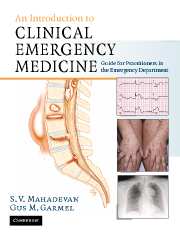Book contents
- Frontmatter
- Contents
- List of contributors
- Foreword
- Acknowledgments
- Dedication
- Section 1 Principles of Emergency Medicine
- Section 2 Primary Complaints
- 9 Abdominal pain
- 10 Abnormal behavior
- 11 Allergic reactions and anaphylactic syndromes
- 12 Altered mental status
- 13 Chest pain
- 14 Constipation
- 15 Crying and irritability
- 16 Diabetes-related emergencies
- 17 Diarrhea
- 18 Dizziness and vertigo
- 19 Ear pain, nosebleed and throat pain (ENT)
- 20 Extremity trauma
- 21 Eye pain, redness and visual loss
- 22 Fever in adults
- 23 Fever in children
- 24 Gastrointestinal bleeding
- 25 Headache
- 26 Hypertensive urgencies and emergencies
- 27 Joint pain
- 28 Low back pain
- 29 Pelvic pain
- 30 Rash
- 31 Scrotal pain
- 32 Seizures
- 33 Shortness of breath in adults
- 34 Shortness of breath in children
- 35 Syncope
- 36 Toxicologic emergencies
- 37 Urinary-related complaints
- 38 Vaginal bleeding
- 39 Vomiting
- 40 Weakness
- Section 3 Unique Issues in Emergency Medicine
- Section 4 Appendices
- Index
28 - Low back pain
Published online by Cambridge University Press: 27 October 2009
- Frontmatter
- Contents
- List of contributors
- Foreword
- Acknowledgments
- Dedication
- Section 1 Principles of Emergency Medicine
- Section 2 Primary Complaints
- 9 Abdominal pain
- 10 Abnormal behavior
- 11 Allergic reactions and anaphylactic syndromes
- 12 Altered mental status
- 13 Chest pain
- 14 Constipation
- 15 Crying and irritability
- 16 Diabetes-related emergencies
- 17 Diarrhea
- 18 Dizziness and vertigo
- 19 Ear pain, nosebleed and throat pain (ENT)
- 20 Extremity trauma
- 21 Eye pain, redness and visual loss
- 22 Fever in adults
- 23 Fever in children
- 24 Gastrointestinal bleeding
- 25 Headache
- 26 Hypertensive urgencies and emergencies
- 27 Joint pain
- 28 Low back pain
- 29 Pelvic pain
- 30 Rash
- 31 Scrotal pain
- 32 Seizures
- 33 Shortness of breath in adults
- 34 Shortness of breath in children
- 35 Syncope
- 36 Toxicologic emergencies
- 37 Urinary-related complaints
- 38 Vaginal bleeding
- 39 Vomiting
- 40 Weakness
- Section 3 Unique Issues in Emergency Medicine
- Section 4 Appendices
- Index
Summary
Scope of the problem
Back pain affects up to 80% of the general population at some time during their lives. It is one of the most expensive outpatient diseases in medicine and is generally a recurrent problem. Most patients have no serious underlying disease and are termed “uncomplicated.” A few patients will have very serious disease necessitating emergent intervention. The process of identifying those with serious disease from the vast majority of patients with uncomplicated back pain can be difficult.
Anatomic essentials
Acute low back pain refers to pain felt in the lumbosacral spine and paraspinal areas. The pain may originate from lumbosacral structures such as bones (lumbar vertebrae, sacrum and coccyx), intervertebral discs, joints (facet, sacroiliac), soft tissues (muscles, tendons, ligaments), vascular structures, and nervous tissue (spinal cord, nerve roots). Low back pain may also be referred from pelvic, retroperitoneal, and abdominal structures due to shared innervation.
The spinal cord is housed in the spinal column, a series of interconnected bones held in place by complex ligamentous and muscular structures. The spinal cord is surrounded by the dura mater and a series of potential spaces. These spaces are important to clinicians because infection and tumor can seed there. The adult spinal cord ends at approximately the L1–L2 junction. The nerve roots at the end of the spinal cord are known as the cauda equina (horse's tail).
- Type
- Chapter
- Information
- An Introduction to Clinical Emergency MedicineGuide for Practitioners in the Emergency Department, pp. 413 - 426Publisher: Cambridge University PressPrint publication year: 2005

